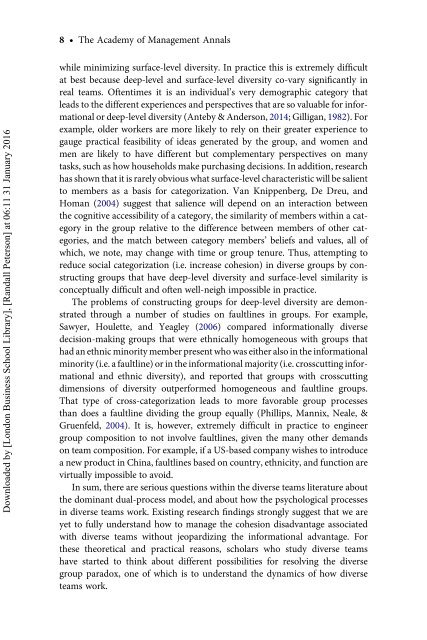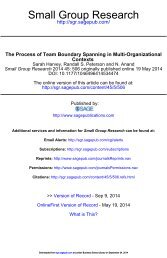A Dynamic Perspective on Diverse Teams: Moving From The Dual Process Model to A Dynamic Coordination-Based Model of Diverse Team Performance - Kannan Srikanth, Sarah Harvey & Randall Peterson
The existing literature on diverse teams suggests that diversity is both helpful to teams in making more information available and encouraging creativity and damaging to teams in reducing cohesion and information sharing. Thus the extant literature suggests that diversity within teams is a double-edged sword that leads to both positive and negative effects simultaneously.
The existing literature on diverse teams suggests that diversity is both helpful to teams in making more information available and encouraging creativity and
damaging to teams in reducing cohesion and information sharing. Thus the
extant literature suggests that diversity within teams is a double-edged sword
that leads to both positive and negative effects simultaneously.
Create successful ePaper yourself
Turn your PDF publications into a flip-book with our unique Google optimized e-Paper software.
8 † <strong>The</strong> Academy <strong>of</strong> Management Annals<br />
Downloaded by [L<strong>on</strong>d<strong>on</strong> Business School Library], [<strong>Randall</strong> Peters<strong>on</strong>] at 06:11 31 January 2016<br />
while minimizing surface-level diversity. In practice this is extremely difficult<br />
at best because deep-level and surface-level diversity co-vary significantly in<br />
real teams. Oftentimes it is an individual’s very demographic category that<br />
leads <strong>to</strong> the different experiences and perspectives that are so valuable for informati<strong>on</strong>al<br />
or deep-level diversity (Anteby & Anders<strong>on</strong>, 2014; Gilligan, 1982). For<br />
example, older workers are more likely <strong>to</strong> rely <strong>on</strong> their greater experience <strong>to</strong><br />
gauge practical feasibility <strong>of</strong> ideas generated by the group, and women and<br />
men are likely <strong>to</strong> have different but complementary perspectives <strong>on</strong> many<br />
tasks, such as how households make purchasing decisi<strong>on</strong>s. In additi<strong>on</strong>, research<br />
has shown that it is rarely obvious what surface-level characteristic will be salient<br />
<strong>to</strong> members as a basis for categorizati<strong>on</strong>. Van Knippenberg, De Dreu, and<br />
Homan (2004) suggest that salience will depend <strong>on</strong> an interacti<strong>on</strong> between<br />
the cognitive accessibility <strong>of</strong> a category, the similarity <strong>of</strong> members within a category<br />
in the group relative <strong>to</strong> the difference between members <strong>of</strong> other categories,<br />
and the match between category members’ beliefs and values, all <strong>of</strong><br />
which, we note, may change with time or group tenure. Thus, attempting <strong>to</strong><br />
reduce social categorizati<strong>on</strong> (i.e. increase cohesi<strong>on</strong>) in diverse groups by c<strong>on</strong>structing<br />
groups that have deep-level diversity and surface-level similarity is<br />
c<strong>on</strong>ceptually difficult and <strong>of</strong>ten well-neigh impossible in practice.<br />
<strong>The</strong> problems <strong>of</strong> c<strong>on</strong>structing groups for deep-level diversity are dem<strong>on</strong>strated<br />
through a number <strong>of</strong> studies <strong>on</strong> faultlines in groups. For example,<br />
Sawyer, Houlette, and Yeagley (2006) compared informati<strong>on</strong>ally diverse<br />
decisi<strong>on</strong>-making groups that were ethnically homogeneous with groups that<br />
had an ethnic minority member present who was either also in the informati<strong>on</strong>al<br />
minority (i.e. a faultline) or in the informati<strong>on</strong>al majority (i.e. crosscutting informati<strong>on</strong>al<br />
and ethnic diversity), and reported that groups with crosscutting<br />
dimensi<strong>on</strong>s <strong>of</strong> diversity outperformed homogeneous and faultline groups.<br />
That type <strong>of</strong> cross-categorizati<strong>on</strong> leads <strong>to</strong> more favorable group processes<br />
than does a faultline dividing the group equally (Phillips, Mannix, Neale, &<br />
Gruenfeld, 2004). It is, however, extremely difficult in practice <strong>to</strong> engineer<br />
group compositi<strong>on</strong> <strong>to</strong> not involve faultlines, given the many other demands<br />
<strong>on</strong> team compositi<strong>on</strong>. For example, if a US-based company wishes <strong>to</strong> introduce<br />
a new product in China, faultlines based <strong>on</strong> country, ethnicity, and functi<strong>on</strong> are<br />
virtually impossible <strong>to</strong> avoid.<br />
In sum, there are serious questi<strong>on</strong>s within the diverse teams literature about<br />
the dominant dual-process model, and about how the psychological processes<br />
in diverse teams work. Existing research findings str<strong>on</strong>gly suggest that we are<br />
yet <strong>to</strong> fully understand how <strong>to</strong> manage the cohesi<strong>on</strong> disadvantage associated<br />
with diverse teams without jeopardizing the informati<strong>on</strong>al advantage. For<br />
these theoretical and practical reas<strong>on</strong>s, scholars who study diverse teams<br />
have started <strong>to</strong> think about different possibilities for resolving the diverse<br />
group paradox, <strong>on</strong>e <strong>of</strong> which is <strong>to</strong> understand the dynamics <strong>of</strong> how diverse<br />
teams work.
















